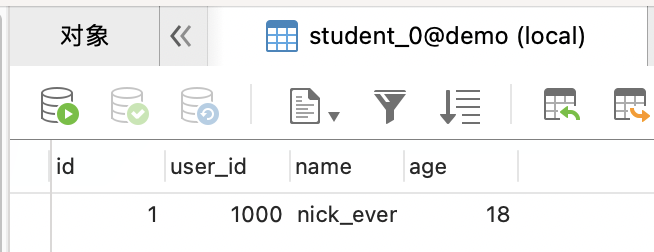聊聊 Sharding-Jdbc 的简单使用
作者:Nick
- 2022 年 6 月 01 日
本文字数:2343 字
阅读完需:约 8 分钟

我们在日常工作中还是使用比较多的分库分表组件的,其中比较优秀的就有 Sharding-Jdbc,一开始由当当开源,后来捐献给了 Apache,说一下简单使用,因为原来经常的使用都是基于 xml 跟 properties 组合起来使用,这里主要试下用 Java Config 来配置首先是通过 Spring Initializr 创建个带 jdbc 的 Spring Boot 项目,然后引入主要的依赖
<dependency> <groupId>org.apache.shardingsphere</groupId> <artifactId>shardingsphere-jdbc-core</artifactId> <version>5.0.0-beta</version></dependency>
复制代码
因为前面有聊过 Spring Boot 的自动加载,在这里 spring 就会自己去找 DataSource 的配置,所以要在入口把它干掉
@SpringBootApplication(exclude = { DataSourceAutoConfiguration.class})public class ShardingJdbcDemoApplication implements CommandLineRunner {
复制代码
然后因为想在入口跑代码,就实现了下 org.springframework.boot.CommandLineRunner 主要是后面的 Java Config 代码
// 注意这里的注解,可以让 Spring 自动帮忙加载,也就是 Java Config 的核心@Configurationpublic class MysqlConfig {
@Bean public DataSource dataSource() throws SQLException { // Configure actual data sources Map<String, DataSource> dataSourceMap = new HashMap<>();
// Configure the first data source // 使用了默认的Hikari连接池的 DataSource HikariDataSource dataSource1 = new HikariDataSource(); dataSource1.setDriverClassName("com.mysql.jdbc.Driver"); dataSource1.setJdbcUrl("jdbc:mysql://localhost:3306/sharding"); dataSource1.setUsername("username"); dataSource1.setPassword("password"); dataSourceMap.put("ds0", dataSource1);
// Configure student table rule // 这里是配置分表逻辑,逻辑表是 student,对应真实的表是 student_0 到 student_1, 这个配置方式就是有多少表可以用 student_$->{0..n} ShardingTableRuleConfiguration studentTableRuleConfig = new ShardingTableRuleConfiguration("student", "ds0.student_$->{0..1}");
// 设置分表字段 studentTableRuleConfig.setTableShardingStrategy(new StandardShardingStrategyConfiguration("user_id", "tableShardingAlgorithm"));
// Configure sharding rule // 配置 studentTableRuleConfig ShardingRuleConfiguration shardingRuleConfig = new ShardingRuleConfiguration(); shardingRuleConfig.getTables().add(studentTableRuleConfig);
// Configure table sharding algorithm Properties tableShardingAlgorithmrProps = new Properties(); // 算法表达式就是根据 user_id 对 2 进行取模 tableShardingAlgorithmrProps.setProperty("algorithm-expression", "student_${user_id % 2}"); shardingRuleConfig.getShardingAlgorithms().put("tableShardingAlgorithm", new ShardingSphereAlgorithmConfiguration("INLINE", tableShardingAlgorithmrProps));
// 然后创建这个 DataSource return ShardingSphereDataSourceFactory.createDataSource(dataSourceMap, Collections.singleton(shardingRuleConfig), new Properties());
}}
复制代码
然后我们就可以在使用这个 DataSource 了,先看下这两个表的数据


@Override public void run(String... args) { LOGGER.info("run here"); String sql = "SELECT * FROM student WHERE user_id=? "; try ( Connection conn = dataSource.getConnection(); PreparedStatement ps = conn.prepareStatement(sql)) { // 参数就是 user_id,然后也是分表键,对 2 取模就是 1,应该是去 student_1 取数据 ps.setInt(1, 1001);
ResultSet resultSet = ps.executeQuery(); while (resultSet.next()) { final int id = resultSet.getInt("id"); final String name = resultSet.getString("name"); final int userId = resultSet.getInt("user_id"); final int age = resultSet.getInt("age"); System.out.println("奇数表 id:" + id + " 姓名:" + name + " 用户 id:" + userId + " 年龄:" + age ); System.out.println("============================="); } // 参数就是 user_id,然后也是分表键,对 2 取模就是 0,应该是去 student_0 取数据 ps.setInt(1, 1000); resultSet = ps.executeQuery(); while (resultSet.next()) { final int id = resultSet.getInt("id"); final String name = resultSet.getString("name"); final int userId = resultSet.getInt("user_id"); final int age = resultSet.getInt("age"); System.out.println("偶数表 id:" + id + " 姓名:" + name + " 用户 id:" + userId + " 年龄:" + age ); System.out.println("============================="); } } catch (SQLException e) { e.printStackTrace(); } }
复制代码
看下查询结果

划线
评论
复制
发布于: 刚刚阅读数: 4
版权声明: 本文为 InfoQ 作者【Nick】的原创文章。
原文链接:【http://xie.infoq.cn/article/add8a28d9a04a59bbdc6d311f】。文章转载请联系作者。
Nick
关注
还未添加个人签名 2017.12.22 加入
写代码的阿森 https://nicksxs.me https://nicksxs.com 也可以看我的博客











评论